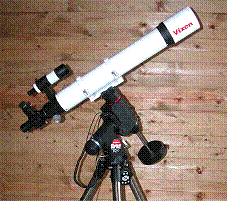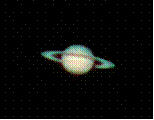Double-Barreled Product Review: A 4-inch Refractor and Mount
Jack Kramer
For many years (twelve, to be exact) I used a Celestron GP-C102 4-inch achromatic refractor when I didn't feel like setting up a larger scope. Because it had a motor drive, it also served very well as a camera platform for piggyback wide-field imaging. It's often said that the "best" telescope is the one you use most often, and I probably used the GP-C102 more frequently than any of my other telescopes. As is typical of good refractors, it presented sharp, high contrast images that made it a joy to use, and under really dark skies it showed an amazing number of fainter deep sky objects. But as is also typical of simple achromats, there was a purple halo of chromatic aberration around bright objects. Nonetheless I liked that telescope so much that I often said I'd never get rid of it ... but I did just that. Love is fickle.
Considering image quality and convenience, a 4-inch refractor worked out well for me as a grab-and-go telescope. The replacement for my beloved GP-C102 would be something in that size range.
Vixen ED100SF: My first requirement was that the replacement should be an apochromat, so as to reduce the chromatic aberration to a minimal level and perhaps gain some additional light throughput. There are various types of apochromats. Typically, those with a fluorite lens or a three element objective have virtually no aberration of any kind and tend to be of somewhat shorter focal length, thus offering a wider field of view. But they are also the most expensive, generally priced in the $3000 range for a 4-inch. Since this isn't my "main" telescope, I wasn't willing to invest that kind of money, but would settle for a two-element ED (enhanced dispersion) design that controls most of the aberrations. These types are usually priced in the neighborhood of $900 to $1400.
 The GP-C102 carried the Celestron brand name, but was actually made in Japan by Vixen. (This was before the Chinese-made clones hit the market.) Experience prompted me to lean toward Vixen, though I checked out several different brands of 4-inch apochromatic refractors, including Astro-Tech, Stellarview, William Optics, Orion, and Borg. Those models come without a finder or with a 1x red dot type finder; however, I prefer an optical finder, and the Vixen includes an 8x50 finder scope. Although a dovetail shoe for an optical finder could be added to any telescope, that would entail drilling the tube for mounting screws.
The GP-C102 carried the Celestron brand name, but was actually made in Japan by Vixen. (This was before the Chinese-made clones hit the market.) Experience prompted me to lean toward Vixen, though I checked out several different brands of 4-inch apochromatic refractors, including Astro-Tech, Stellarview, William Optics, Orion, and Borg. Those models come without a finder or with a 1x red dot type finder; however, I prefer an optical finder, and the Vixen includes an 8x50 finder scope. Although a dovetail shoe for an optical finder could be added to any telescope, that would entail drilling the tube for mounting screws.
Another requirement was a 2" visual back so it would be possible to use 2" format wide field eyepieces. All the scopes of this type now come so equipped. A further convenience would be for the scope to include a universal dovetail bracket that would fit most mounts in this size range.
I settled on the Vixen ED100SF because it has the features I desired, plus it comes with a nice aluminum storage case. At the 2007 Illinois Dark Sky Star Party I had a chance to look through Travis Whitlow's ED80SF and was impressed with the design and image quality.
The scope includes a smooth Crayford focuser. A unique feature of current Vixen models is their use of a flip mirror 11/4" star diagonal. A lever on the side of the diagonal changes the orientation from 90o to straight through. Presumably, this would allow a camera to be mounted in the straight-through configuration while visually acquiring an object with an eyepiece in the right angle position. However, I generally use a Tele Vue 2" dielectric mirror diagonal instead of the flip mirror.
Though Vixen is a Japanese brand, several of their scopes, including the ED100SF, are now made in China. In fact, (except for the color) the finder scope is identical to the finder that came with my Chinese-made Orion XT12i Dobsonian. The ED100SF has an f/9 optical system, which is slow enough to contribute toward minimizing any aberrations. Vixen also sells an ED103SWT model with an f/7.7 optical system that is 3mm larger in diameter. It costs $400 more, I suspect mainly due to the slightly larger optics and tighter optical correction required by the faster focal ratio.
After a two-month wait due to the ED100SF being on backorder, I was able to do a side-by-side comparison with the GP-C102. The first thing I noted was that the image color in the apo is much "cooler"; in fact, the images in the achromat appeared yellowish by comparison. This no doubt is due to the fact that achromats reach sharpest focus in the yellow band of the spectrum where our eyes are more sensitive, while the red and blue bands are mostly out of focus. With more colors coming to focus in the same visual plane, the apo presents images that are whiter in color with no apparent chromatic aberration. The better images may also be partly due to more recent improvements in lens coatings. The apo takes a bit longer to acclimate to cold outside temperatures and seems somewhat more sensitive to atmospheric instability. But once everything settles down, the images have that typical refractor "snap". Moreover, images in the apo are brighter and have higher contrast.
 Having used the ED100SF for a while now, I know its capabilities. Under ideal observing conditions, it easily shows clouds on Saturn, the Cassini division, and as many as six of its moons. I took the image here through that scope this past April. With a wide field eyepiece, the galaxies M65, M66, and NGC3628 in Leo fit nicely in the same field of view, and it's possible to make out some structure in M51. Even in mediocre skies the brighter globular clusters are better resolved than in the GP-C102. The ability to use 2" eyepieces was especially handy for observing the large comet 17/P Holmes that graced our sky at the time of first light.
Having used the ED100SF for a while now, I know its capabilities. Under ideal observing conditions, it easily shows clouds on Saturn, the Cassini division, and as many as six of its moons. I took the image here through that scope this past April. With a wide field eyepiece, the galaxies M65, M66, and NGC3628 in Leo fit nicely in the same field of view, and it's possible to make out some structure in M51. Even in mediocre skies the brighter globular clusters are better resolved than in the GP-C102. The ability to use 2" eyepieces was especially handy for observing the large comet 17/P Holmes that graced our sky at the time of first light.
Orion Sirius EQ-G: The other half of a telescope setup is the mounting, and I actually bought a new mounting before deciding to replace the achromatic refractor. The Vixen Great Polaris that comes with the GP-C102 is a decent mount, but it has an annoying idiosyncrasy. Without a slip clutch, it was necessary to lock the axes using a lever on each axle housing in order to engage the drive. The location of these levers often placed them in positions that were awkward to reach. Then it was necessary to unlock the axes in order to move the scope on to another object. I griped to myself about this "feature" just about every time I used the GP-C102. Enough of that!
Orion's Sirius EQ-G German equatorial mount easily handles a 4-inch refractor. I had also considered a Losmandy GM-8 mount, which would no doubt have a more accurate and robust drive system, but was priced almost $1000 more than a comparably equipped Sirius EQ-G. For my mostly visual observing, I reasoned that I didn't need the very best. In fact, the tracking of the Sirius turned out to be extremely good, with merely a quiet chirping sound to signal that the mount is driving.
The features of the mount are a pleasant surprise. Of course, it has a slip clutch, which means that during an evening's observing you don't have to mess with the drive system, unless you want to switch from tracking to fast slewing, which can be done from the hand controller. Also, the drive motors are completely enclosed within the mount. And there's a polar axis finder that is always illuminated when the drive is powered. Another convenience is that the declination axle can be slid up and locked out of the way in the axle housing when transporting the mount (after first removing the counterweight).
The fact that the Sirius mount is rated with a payload capacity of 30 lbs. versus the Great Polaris' 15 lbs. means that it holds the telescope more securely, with noticeably less vibration than the GP, even when focusing the telescope. The down side is that the Sirius, minus the counterweight, is about half again as heavy as the GP mount with its counterweight. The old GP mount was powered by an on-board 9-volt "transistor radio" battery, whereas with the Sirius it's necessary to also haul out a 12-volt battery pack.
Conclusion: The ED100SF/Sirius EQ-G combo is a compromise that ended up costing about $2300. But that's only $500 more than the GP-C102 cost over twelve years ago - a reasonable price for some considerable advantages. For an additional $300, a go-to controller can be added to the Sirius mount. Despite the tradeoff of a heavier mount and a bit more setup effort, I'm satisfied with the result, which has provided all the things that my old GP-C102 didn't have. Due to its weight, this 4-inch combo is certainly pushing the definition of a "grab-and-go" telescope. But there are lighter weight alternatives.
Here's a final thought regarding refractors in general. I happen to be a fan of this telescope design due to the crisp images, plus the black sky background further enhances the high contrast. This makes a refractor seem as though it's performing well beyond the limits of its aperture. And there's something "classic" about the look of a refractor. There must be a lot of people who feel that way because these days there's a large selection of modern apochromatic refractors on the market. One thing is still certain however - aperture rules. A good 8-inch Newtonian on a Dobsonian mount will outperform any 4-inch refractor in terms of resolution and light grasp, while being just as easy to handle. As nice as they are, refractors can't defy the laws of physics. (And like all new equipment, it jinxed the weather, being the probable cause of an extended period of clouds, cold weather, and snow shortly after I received it!)
Published in the June 2008 issue of the NightTimes




